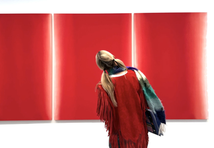A Litmus Test with a Yellow Stripe: All Eyes on Christie’s as the Weis Collection Meets the Gavel
- The Courtauldian
- Oct 15
- 3 min read
Harry Laventure

The deaths of Robert F. and Patricia G. Ross Weis, in October 2015 and 2024, marked the loss of two of the art world’s most private, understated collectors. The taste and acquisition harboured thereby held the instinctive and refined symmetry of a dragonfly’s wings. For over seventy years, the pair plucked a coherent anthology of postwar masterpieces from the market, gently amassing some of modern art’s finest Lepidoptera for kitchen, dining room, or in one Matisse’s case, the spot above the sofa. The names therein line the walls of the most valuable museum collections in the world, and the spines of art history’s more recent studies. Rothko, Picasso, and Mondrian are but a tricolon of those most often printed in embossed fonts. For better or worse, the reserved habits of these connoisseurs denied the works exposure to public daylight for decades. In November this will change, and our monetary reaction to their sale will diagnose much more than wonder. Market anaphylaxis, or market galvanisation?
In a joint statement, the three Weis children announced that, taking the set to auction, their ‘stewardship of [the art] will pass to others who we hope will be equally inspired by the beauty and depth of feeling that the collection evokes’. This touching sentiment is bolstered by an $180million valuation. Rothko’s No. 31 (Yellow Stripe) is a magnificent Colour Field expanse of crimson and honey, the yield of which is estimated to be $50million, taking the top seed above Picasso’s La Lecture ($40million), Matisse’s Figure et bouquet (Tête ocre) (up to $25million), and Mondrian’s Composition with Red and Blue (between $20million and $30million) [ARTNews]. The illustrious company of these blue-chip veterans is a welcome return for the art market, and we may only hope that the shaken bottle confers the popping cork.

More than any other, this will be the wager of Christie’s. The New York Times has reported that the leading auction house’s confidence has pecuniary charge to it, offering to pay an advance of nearly $200million to secure the group. Given their flat year thus far, this is a bold gambit. For their buck, alongside the lodestars above, there will be a total of 80 lots - of this, 18 will go into single-owner sale, with the remainder distributed between the three day sales.
Personally, I sincerely hope that this bravery is duly rewarded. Given auction houses’ recent attraction to and forays within the luxury goods market, it is refreshing to greet bastions of art’s most lucrative movements back into the frame. Only a handful of years ago, a sale of this magnitude would exert a magnetism of elephantine proportions on the buying market. Come November, a record-breaking evening may perhaps be radical to the point of fantasy, but a weak performance would be a crushing confiscation of air. As such, for those not bidding, this must be perceived as a barometer of market health. Art’s market blessings are its curses, after all; in the arena of true subjectivity, confidence is equivalent to value.

But confidence is, more than anything, a choice: the substantiation of a whim in a decisive moment at risk. At present, UBS are predicting a 93% chance of recession [yahoo! finance]. As Masterworks have recently published to their investors, diversification is paramount to surviving such a collapse. In the past, in times of global financial crisis, art has idiosyncratically straddled a low correlation with traditional markets whilst overall outpacing them. As such, the November auctions of the Weis Collection may just harbour the unique opportunity for buyers to steal some of art’s most reliable assets, prior to their impending escalation – or, at worst, retention - in value. The blue-chips, the last seventy years would appear to suggest, are never down.
Regardless, it is a privilege to have these works back in circulation, and a serendipitously concentrated inoculation of established value. Their sales will reflect not just the state of our attitudes to the monetary value of art, but the strength of its position as an alternative investment. This, again, is a choice. Experiences do not have stocks attached.
Robert F. Weis once remarked that there is ‘no substitute for looking’. As the final hammer of the sale comes down, it is no understatement to say that we simply won’t have the choice.












Comments